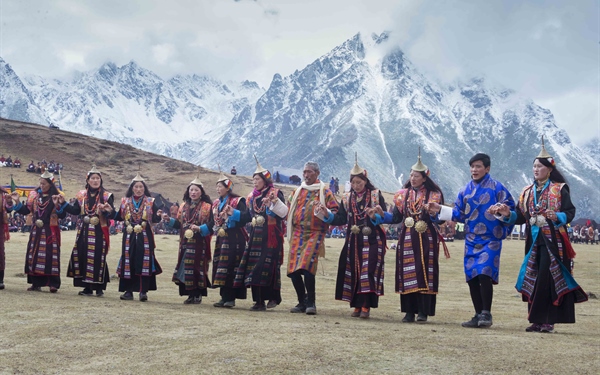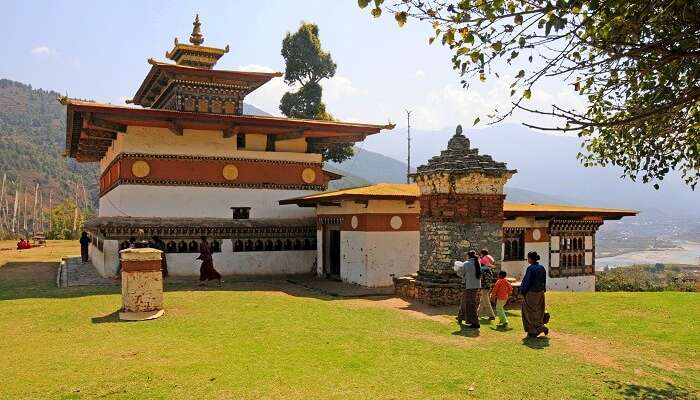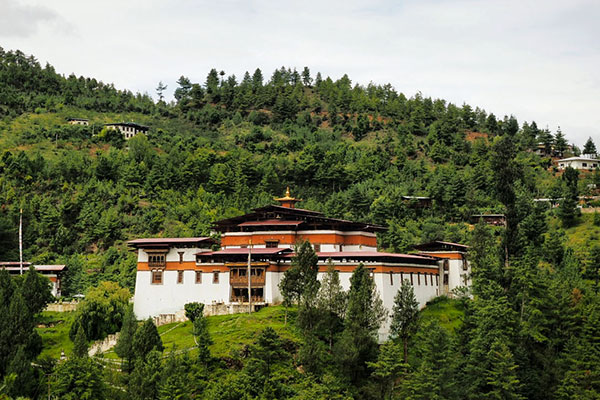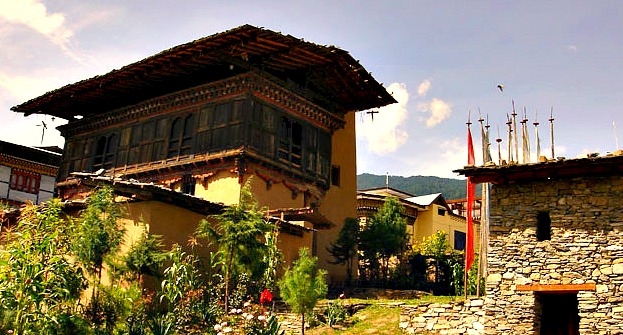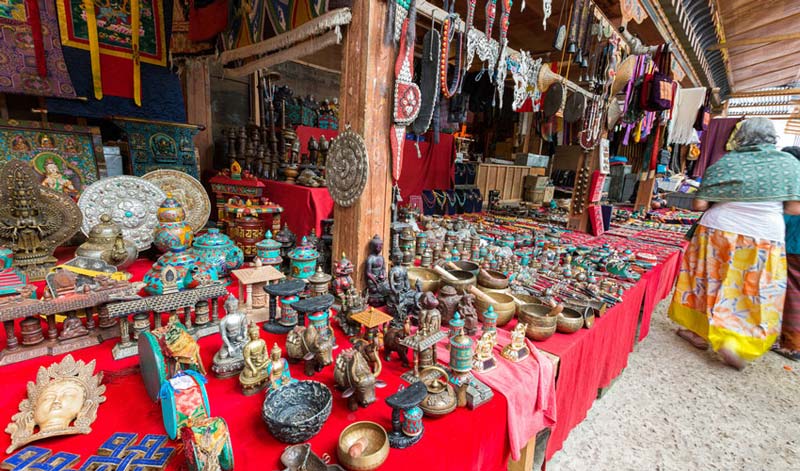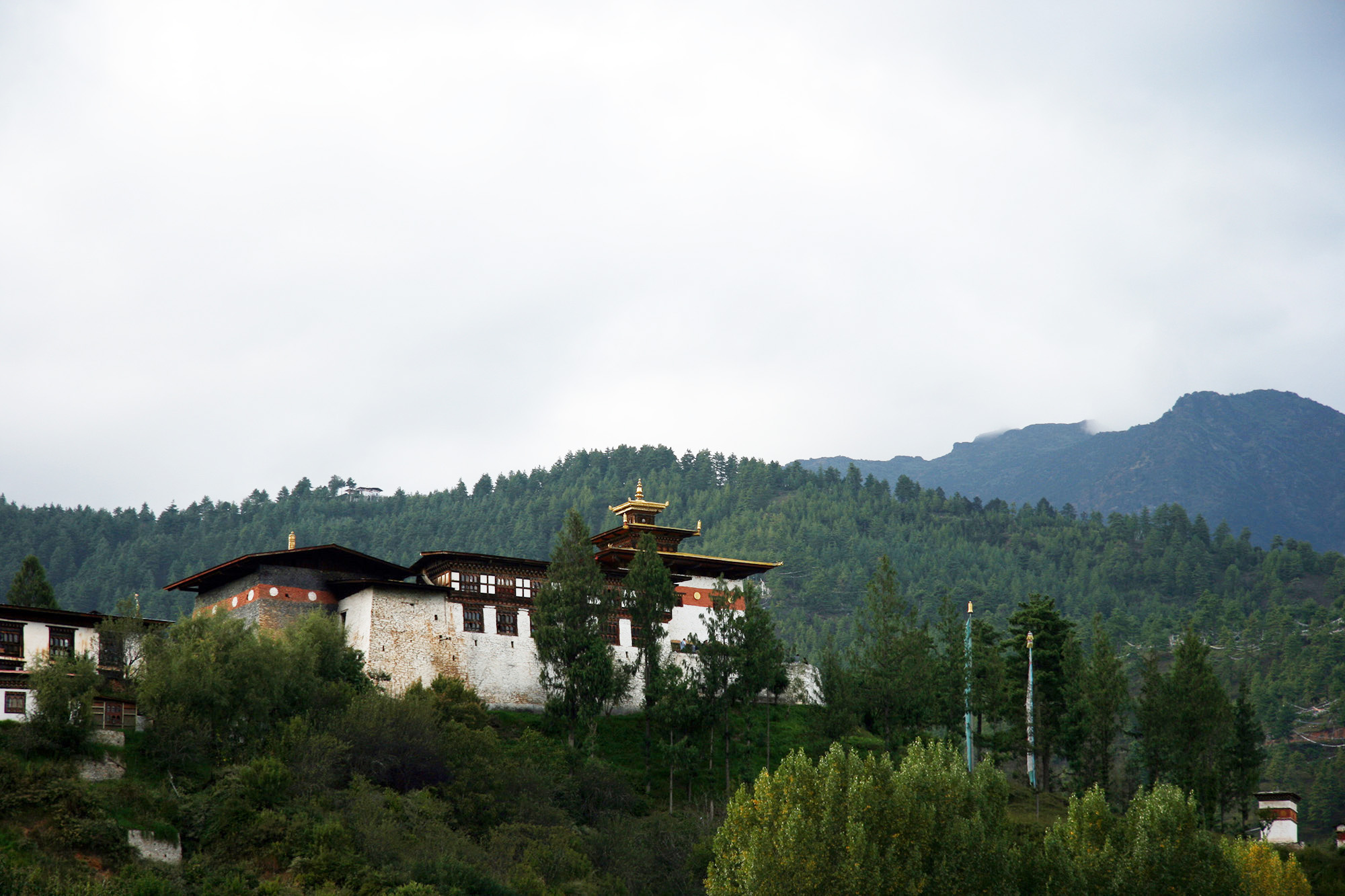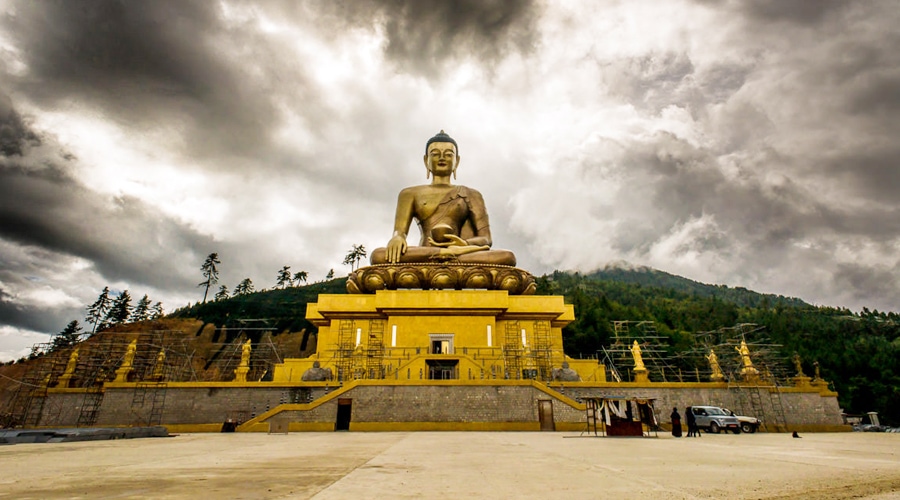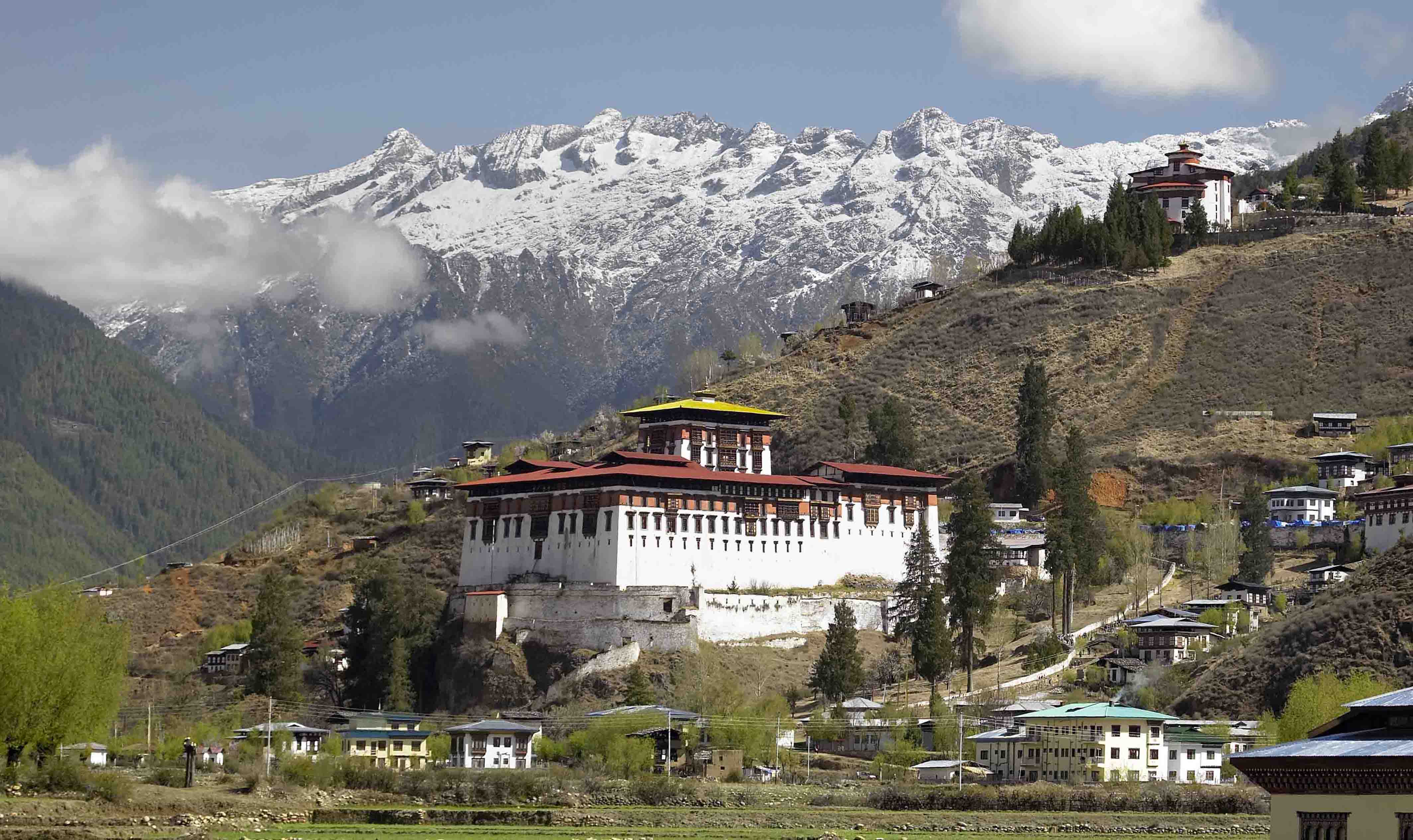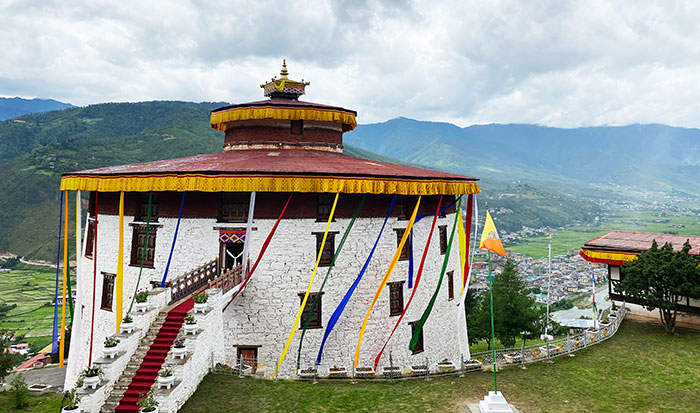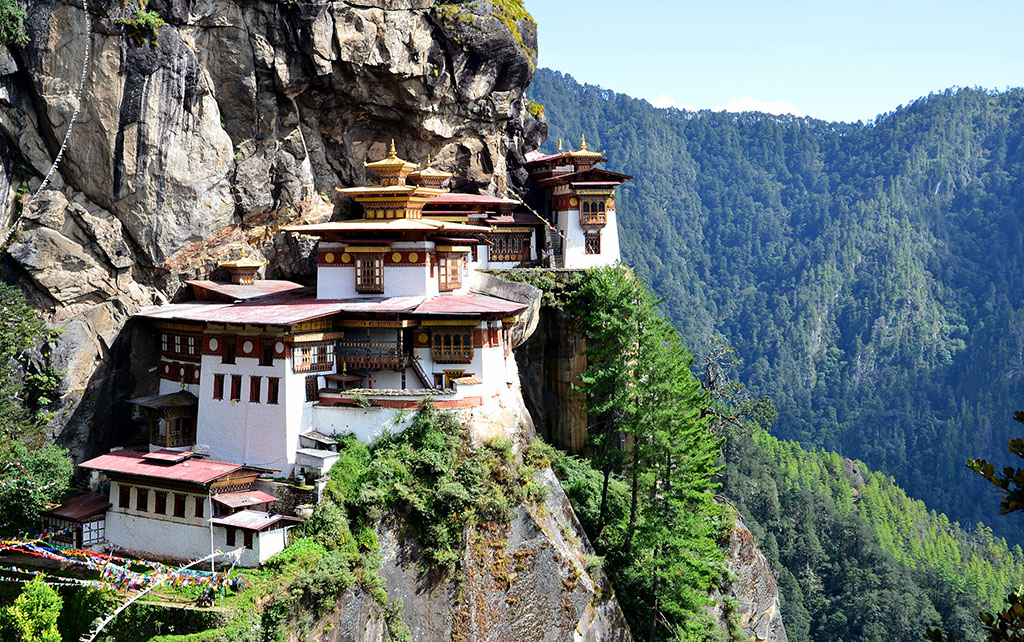Thimphu, the capital city of Bhutan, sprawls along a valley at an altitude of 2,300 meters. It was in 1961 that Thimphu replaced Punakha as the capital. It is estimated that about 100,000 people reside in Thimphu making it the most populated district in the country. Thimphu is a mixture of residents from all over the country as it is the center of government, religion and commerce.
The city is unique. After Pyongyang, North Korea, Thimphu is the only other national capital in the world with no traffic lights. Small and secluded, the city is quiet and the traffic jams are hardly a thing of concern. There is so much to see in Thimphu that you can spend several days here. The proximity of many of the sights makes it possible and easier to travel in the town on foot and provide you with the chance of observing the culture and the Bhutanese way of life. Unlike many modern cities, Thimphu has kept a strong national character in its architectural style.
Places of interest in and around Thimphu:
1. Memorial Chorten:
While chortens are the most visible religious monuments found in and around Thimphu, the memorial chorten is special to the locals because it is, like the name suggests, built in memory of the father of Bhutan – His Majesty the Third King, Jigme Dorji Wangchuck.
Only about a five-minute walk from the main traffic, one can see people circumambulate the chorten throughout the day. Standing tall in the heart of the city, the white structure, with its golden finial, is adorned with richly painted thankas, elaborate mandalas, splendid statues and a shrine dedicated to His Majesty the Third King.
2. Simtokha Dzong:
The foundation of the dzong was laid in 1627 by Zhabdrung Ngawang Namgyel, and was built by Tango Chhoje Mipham Tshweang Tenzin. It was completed in 1631, making it the first dzong ever built in Bhutan. It was rebuilt in 2008, with great emphasis on retaining the original architectural structure intact. At present, it is used as the Royal Institute of Dzongkha Language where Buddhist studies are conducted.
It nestles on a lofty ridge about six kilometers south of Thimphu. The most noteworthy artistic feature of this dzong is the series of over 300 finely worked slate carvings behind the prayer wheels in the courtyard.
3. National Library:
Established in 1976 in order to preserve ancient texts both in Dzongkha and Tibetan, the National Library is a good resource for books about Bhutan.
Scriptures from all religious schools are represented here, including that from Bon tradition. Most of the books are printed on long strips of handmade paper stacked between pieces of wood and wrapped in silken cloth. Also on display are ancient photographs, a copy of the 1783 letter sent by the Desi (Secular Ruler) to Samuel Turner – a British army officer and surveyor.
4. Institute for Zorig Chusum:
Imparting courses in Bhutan’s 13 traditional arts, Zorig Chusum also known as the painting school is a photographers’ dream and for a layman it’s hard not to be impressed with the skill and discipline that goes into various forms of paintings, woodcarving, embroidery and statue-making.
Nearby, in the vicinity are several handicraft shops.
5. Traditional Medicine Institute (Indigenous Hospital):
Bhutan was once known as Lho jong men jong, literally meaning the ‘’southern country of medicinal herbs’’, as Bhutan has an abundance of medicinal herbs. In an attempt to preserve the rich culture and tradition, an indigenous dispensary was opened on 28 June 1968 at Dechencholing. In 1979 it was upgraded to the National Indigenous Hospital and was shifted to Kawajangsa. In 1998, it came to be known as the Institute of Traditional Medicine Services. In the institute patients are treated using the various traditional medicines and age-old methods. The Institute also imparts the art of herbal medicines to students.
6. The Folk Heritage Museum:
This restored building actually replicates a Bhutanese farmhouse from about a century ago. This life-like museum provides a glimpse into rural Bhutanese life. After the tour, you can enjoy an authentic Bhutanese lunch, with butter tea, chilies, dried meat and the lot at the restaurant there for only Nu 250.
Both the museums, opened in 2001, are dedicated to the traditions and lifestyle of Bhutanese. While the Textile Museum beautifully displays the Bhutanese garments from the 1600s up to the present, the Folk Heritage Museum delves into portraying the daily life of the rural folk and allows you to examine a traditional Bhutanese home.
7. National Textile Museum:
To learn firsthand about this tiny Himalayan Kingdom’s art of weaving, the National Textile Museum is worth a trip. A visit will introduce you to the major weaving techniques, styles and the type of textiles made by both women and men. If you are lucky, you may even come across a group of weavers operating their looms inside the museum.
8. Trashichhoedzong:
The Dzong (fortress), along the bank of the Wang Chhu, is an architectural delight and houses the throne room, and offices of His Majesty the King and the ministries of home affairs and finance. It also is the summer residence of the dratshang (monk body).
Destroyed by fires in the 1700s and by an earthquake in 1897, it was rebuilt in 1902. Today, surrounded by well-kept lawns and beautiful gardens, the massive structure provides a majestic grandeur to the city. Visitors can marvel at Bhutanese architecture and craftsmanship at its finest, where the entire fortress was built without the use of any nails. Its courtyards are a place of gathering for the locals, dressed in their best attires, during the tshechus and other religious festivals.
9. Local Handicraft Shops:
There are several handicraft shops in Thimphu offering various selections of hand-woven and crafted products. Visitors will find beautiful weaves in wool, silk, cotton and basketwork. Thangkas and other traditional crafts are also available, including Bhutanese antiques and various souvenirs. There are also special selection of books on Buddhism and modern English writings by Bhutanese authors.
10. The Centenary Farmer’s Market:
The Centenary Farmers’ Market or the Weekend Market, north of Changlimithang Stadium, is situated along the bank of Wang Chhu. Come Thursday, and vendors from all over the country start pouring in and remain until Sunday night to sell their wares.
Walk around this double-storey market and you’ll find the air go from pungent to sweet to aromatic depending on the produce that is on display – from dried-fish to datse balls, seasonal vegetables and fruits and spices. Across the market and the footbridge (Kundeyling Baazam), one can find a collection of clothing and handicraft stalls. While there are wooden bowls, prayer beads, amulets, prayer wheels and the lot on offer, if you look carefully you could find some treasure amid the heap.
11. Changangkha Lhakhang:
This 12th century temple perched on a hilltop above Thimphu valley constantly buzzes with pilgrim activity. Tibetan lama Phajo Drukgom Shigpo established it. The protective deity of the Lhakhang – Tamdrin, is supposed to bless newborns, hence parents from near and far come here to bless their children and get auspicious names for them.
Only a few minutes of walk up from the road, the monastery offers a magnificent view of the city below. The main chamber of the monastery houses the graven image of Avalokiteshvara, the Buddha of Compassion.
12. Craft Bazaar:
Organised on Tuesday and Wednesday in Centenary Farmer’s market, under patronage of Department of cottage & small industry and in collaboration with the department of culture, tourism council and the department of agriculture marketing and cooperatives, this market offers genuine Bhutanese arts & crafts thus contributing in promotion, protection and preservation of traditional arts.
13. Jungshi Handmade Paper Factory:
Junghi Paper factory comprises of two enterprises ; the unit in Thimphu produces traditional handmade paper from natural plants mainly from ‘Daphne’ plant species which is insect-resistant. The other unit in Jimina, 22 km from the centre Thimphu town, recycles waster papers. The traditional handmade papers are widely used for religious scripts, packing materials, hand-carry bags, lampshades, envelopes, calendars . The paper looks a lot like Japanese washi, and in fact a lot of Bhutanese paper is exported to Japan also.
14. Zangthopelri Lhakhang:
Zangtopelri temple is located next to the Changlimithang Stadium. It is thought of as one of the sacred passes to heaven according to the sacred books of Guru Rinpoche. Renovated in 1960s, the temple possesses some impressive murals and art treasures. The site was a former battleground in 1885 that was crucial in proving the political supremacy of Sir Ugyen Wangchuck, the first hereditary king of Bhutan. Therefore, the temple was built to appease all kinds of evil.
15. Buddha Point (Kuensel Phodrang):
The drive up to Kuensel Phodrang is worth it not only for the view of Thimphu valley from up there but also to simply marvel at the immense size of the Buddha statue that sits majestically on the hilltop. The statue was made in China and shipped and trucked into Bhutan after it was cut into pieces. At a height of 169 feet, it is one of the biggest Buddha Dordenma statues in the world. The massive three-storey throne holds several chapels and the Buddha’s body itself is filled with 125,000 smaller statues.
This massive statue of Shakyamuni measures in at a height of 51.5 m, making it one of the largest statues of Buddha in the world. The statue is made of bronze and is gilded in gold. Each of these thousands of Buddhas have also been cast in bronze and gilded. The throne that the Buddha Dordenma sits upon is a large meditation hall.
16. Simply Bhutan Museum:
Simply Bhutan is an exclusive project under the simply bhutan museum Bhutan Youth Development Fund (YDF), built to offer a unique experience to its visitors. It is a living museum and studio encapsulating the cultural heritage of the Bhutanese people. A distinctive feature of Simply Bhutan is that it fully operated by young people and job seekers, who receive here on the job training in basic business & management skills, customer care and other spheres of life. The fund generated through Simply Bhutan is utilized to run many of the youth development programmes for vulnerable and disadvantaged youth under YDF. Hence as a visitor, while you get to experience and enjoy this special place, you are also helping to ‘make a better today’, ‘a brighter tomorrow’, for the youth of Bhutan.
17. Drubthob Goema / Zilukha Nunnery:
Also called Drubthob goemba, it is one of the few nunneries in Bhutan. Located in Zilukha on a high hill above Tashichhodzong, it houses over 70 nuns. The name Drubthob is of Thangthong Gyalpo, popularly known for building iron bridges during the 15th century. One of his later reincarnations founded the nunnery.
18. Changlimithang Stadium & the Archery Range.
The national stadium in 1885 was the site of the famous battle of Changlimithang that helped establish Sir Ugyen Wangchuck, Bhutan’s first King, as the nation’s political head.
Recently, only about a week back, Bhutan beat Sri Lanka in the world cup qualifiers amidst a packed house of spectators here. But what is equally fun and exciting is the archery ground next-door. Traditional bamboo or carbon-fibre bows really don’t matter, the archers show off their skills and camaraderie with jabs and jibes thrown at the opponent. Songs, alcohol and victory dances are all part of the game.
19. Coronation Park:
Coronation Park is located below the Changlimithang stadium on the bank of Thimphu River. With the area covering over five acres, the park offers a quiet and relaxing environment. Visitors can either stroll through the park or sit and watch the river flow. One section of the park is devoted as a fun area for kids.
20. Thimphu Golf Course
Stretching about 2,800 yards, a par 33 golf course is deemed very challenging by golf enthusiasts. The course is well set up with many obstacles like trees, uneven grass and man-made water pools. Along with the game, players can also enjoy beautiful views of the surrounding valleys with Tashichhodzong right beside the course. There is a clean and homely restaurant where visitors can take a break and also savor some varied local dishes.
21. Botanical Garden
The Botanical Garden is located in Serbithang, about a 10 km drive south of the city. The lush garden covers the hillside offering a peaceful and relaxing environment. It is a paradise for plant enthusiasts as there are wide varieties of indigenous trees, flowers and herbs. The garden also serves as a terrific picnic spot.
22. Takin Preserve
This unique animal, with an appearance between a cow and a goat, is the national animal of Bhutan. There are a number of Takins in the zoo, which is located in a serene, natural environment in Upper Motithang. The walking pavement all around the area offers a tranquil leisurely walk. Legend has it that the great Buddhist yogi, Drukpa Kinley, created the animal.


